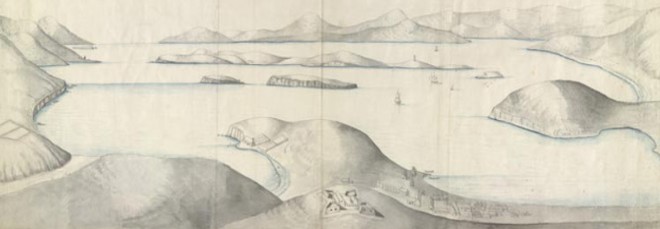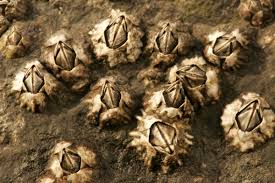That’s an ugly poster you might say, and what’s it telling me through its statement ‘not all plans are idiot proof’?  The lines ‘the best laid plans of mice and men’ from Robbie Burns’s poem come to mind, as well as Steinbeck’s great novel Of Mice and Men. Ah, so is there a friendship between a lean, clever one and a big, stupid one? Is it George and Lennie writ Irish? Well, not really, although, in the film the little one does finish up (spoiler here) doing brain work. But each lad has something to bring to the mix.
The lines ‘the best laid plans of mice and men’ from Robbie Burns’s poem come to mind, as well as Steinbeck’s great novel Of Mice and Men. Ah, so is there a friendship between a lean, clever one and a big, stupid one? Is it George and Lennie writ Irish? Well, not really, although, in the film the little one does finish up (spoiler here) doing brain work. But each lad has something to bring to the mix.
And why is he carrying a hen? And why is he carrying a nail gun? And why is he naked except for his green Y-fronts? And do I want to see The Young Offenders? I probably didn’t. But I did see it, among an audience of eight, at The Gate, Cork.
Most people I know in Cork have decided not to see the film. Not that I know many people in Cork. But I have not yet met anyone who has seen it! That’s a strange thing, I think, since it’s set in the city we are living in (or perhaps not, as who does actually live in the city, other than me and some Apple employees?) and it’s set in the surrounding beautiful countryside and coastline of West Cork. At times the film looks like footage from Fáilte Ireland.
“Oh,” I was told, at the hairdressers, “the lads cannot do a Cork accent”. But a young lad I met in a city shop told me that he was ‘the tall one’s mate’. The tall one, Conor (Alex Murphy) is from Douglas and Jack (Chris Walley) is from Glanmire so I would imagine that their accents are not so bad.
It’s a car-chase film, only with bicycles, and a road trip film which lacks distance. One local place the lads do actually reach is Lough Hyne.
 I have never been there but, coincidentally, the previous week I had attended a workshop, organised by Dr Anna Pilz, here at UCC including a session on ‘Deep Mapping’ at Lough Hyne. This project was presented by Professor of Modern English, Clare Connelly, biologist research assistant, Breda Moriaty, English and History of Art specialist, Dr Michael Waldron and, digital art specialist, Orla-Peach Power.
I have never been there but, coincidentally, the previous week I had attended a workshop, organised by Dr Anna Pilz, here at UCC including a session on ‘Deep Mapping’ at Lough Hyne. This project was presented by Professor of Modern English, Clare Connelly, biologist research assistant, Breda Moriaty, English and History of Art specialist, Dr Michael Waldron and, digital art specialist, Orla-Peach Power.
The project, being undertaken by this inter-disciplinary group ‘investigates biological, cultural and historical context of the south west coast of Ireland from 1700 to 1920. The focus is on the rich maritime environment found along the arc of Cork’s Roaring Water Bay, from Clonakilty to Bantry Bay, as it is shaped by sea and land and as it is imagined within eighteenth- and nineteenth-century cultural texts. The period to be researched begins with the emergence of wide-ranging antiquarian inquiries and poetic responses to the Cork coast and ends with the start of serious biological field research in this area. By advancing a transdisciplinary understanding of this coastline, the project forms a link between cultural history, scientific research and environmental priorities while communicating a sense of cultural identity and fostering ownership of maritime heritage’.
Orla-Peach is ‘responsible for visualising and communicating the range of data collated as part of the Deep Maps project, and is also charged with the task of developing and maintaining an online presence via social media platforms and an integrated website‘.

I was pretty amazed by the project and by the range of people working on it. Breda spoke of the marine life in the lough and I heard for the first time about the invasive barnacle,
 Austrominius modestus, which is threatening the three types of native barnacle along the West Cork coastline. Professor Fiona Stafford, attending from the University of Oxford, commented that she felt that she was an ‘invading barnacle’ in Ireland and I agree that I am too. Much of my study as an MA student of Irish Writing and Film involves me looking at, England, my country, as colonial power: oppressive and exploitative. But speaking to Breda, afterwards, she questioned whether the invasion of Austominius modestus was to be deplored or celebrated. Should she and her colleagues try to expel their immigrant? Or should they let them breed and expand, ousting the native barnacles and colonising the coast of Cork?
Austrominius modestus, which is threatening the three types of native barnacle along the West Cork coastline. Professor Fiona Stafford, attending from the University of Oxford, commented that she felt that she was an ‘invading barnacle’ in Ireland and I agree that I am too. Much of my study as an MA student of Irish Writing and Film involves me looking at, England, my country, as colonial power: oppressive and exploitative. But speaking to Breda, afterwards, she questioned whether the invasion of Austominius modestus was to be deplored or celebrated. Should she and her colleagues try to expel their immigrant? Or should they let them breed and expand, ousting the native barnacles and colonising the coast of Cork?
So, how do these two cultural experiences – watching a film and attending an interdisciplinary workshop at UCC – work as one? Well, it’s Cork all together and ‘the best laid plans of mice and men/ go oft awry’. I wish Austrominius Modestus fáilte.
Works cited
Burns, R. ‘To a Mouse’ Kilmarnock Volume. 1786. John Wilson. Kilmarnock. Print.
Foot, P. Dir. The Young Offenders. 2016. Film
Steinbeck, J. Of Mice and Men. 1937. Covichi Friede. Print.